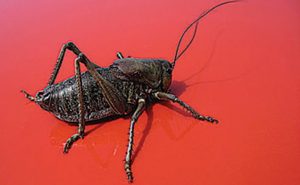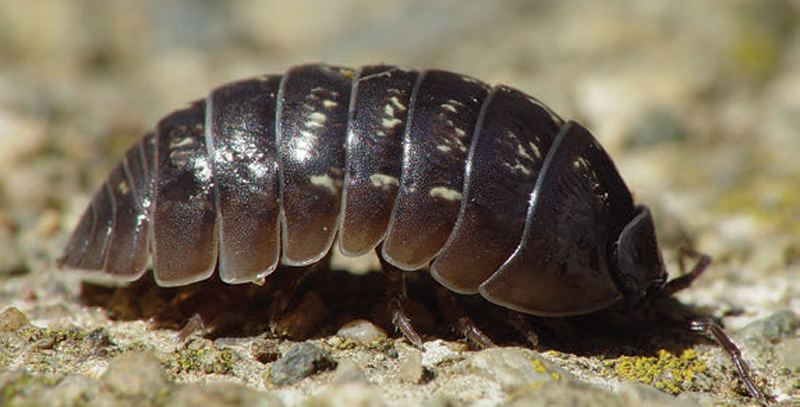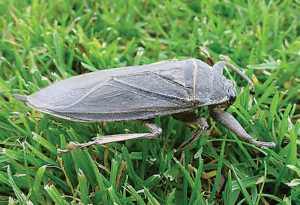IN modern America, protein food that doesn’t come in a Styrofoam container or look like it was sliced off a beef may not pass the supermarket “Eeeewwwww” test. “Finicky omnivore” should be a great oxymoron, but our highly merchandised tastes are missing out on some good groceries just because they don’t look like cow, chicken or salmon.
Insects, for instance, are a good source not only of protein, but also vitamins, minerals, and unsaturated fats. There are some 1,462 recorded species of edible insects—probably more since that tally was made—eagerly eaten by more than 3,000 ethnic groups.
These include 235 species of butterflies and moths, 344 species of beetles, 313 species of ants, bees and wasps, as well as 239 species of grasshoppers, crickets and cockroaches, among others. Other commonly eaten insects are termites, cicadas and dragonflies. Insects are known to be eaten in 80% of the world’s nations. Here, not so much, although in times past they were a staple in the diet of Native Americans and cognoscenti frontiersmen.
Insects have served as traditional foods in most cultures of non-European origin and have played an important role in the history of human nutrition not only in western North America, but also in Africa, Asia and Latin America. Before humans had tools to hunt or farm, insects probably represented an important part of the diet, for the same reason we are discussing them here in a “survival” context: they are easy to catch bare-handed.
A man in a starvation situation has to either lower his standards or broaden his horizons (depending on your point of view) to keep fueled. To sustain life, if you don’t have the food you love, you’d better learn to love the food you have. It’s that simple.
Table of Contents
EAT A BUG? NOT ME!
Of those who vow to starve before they would eat a bug, we might question their virginity if they have been eating from the grocery store. According to the USDA, below are perfectly acceptable levels of bugs, bug parts or bug poop in some typical foods:
- Wheat flour (insect filth): average of up to 150 or more insect fragments per 100 grams
- Frozen broccoli (insects/mites): average of 60 or more aphids and/or thrips and/or mites per 100 grams
- Hops (insects): average of more than 2,500 aphids per 10 grams (that works out to 7,500+ aphids per ounce of hops)
- Ground thyme (insect filth): average of 925 or more insect fragments per 10 grams
- Ground nutmeg (insect filth): average of 100 or more insect fragments per 10 grams
Considering the lingering toxicity of various chlorinated-hydrocarbon or heavy-metal sprays used on food crops to keep them bug-free, I personally don’t mind a few bugs here and there. Even as an entree.
Although bugs from mollusks and myriad larvae, to insects and arachnids admittedly have public relations issues in cultures used to eating only plastic-wrapped, farm-raised animals, it is mostly a problem of perception. Just like chicken, eggs and pork can carry disease or parasites, so can some insects and mollusks. Just like many plants are inedible or toxic, so are some insects, although the percentages favor the prevailing wholesomeness of bugs as opposed to plants. And just like some folks are allergic to shellfish, some may be allergic to these crustaceans as well.
In many cultures, some insects are eaten raw. Personally we always cook chicken and pork—and edible bugs. Depending on species, hard leg parts, wings and heads may be discarded. Fortunately, man has eaten bugs since the dawn of time, and numerous bellyfriendly ones, and recipes, have long since been identified. In a wilderness situation, gourmet cooking may not be possible, but good nutrition is, with bugs.
Let’s think of bugs for a minute as merely more clams, crab, shrimp, lobster, and escargot. Next we’ll examine a Delicious Dozen of the most common, tastiest, and most nutritious bugs you’re likely to find in the wilderness of North America—or your backyard—and that have a long history in human nutrition.

ANTS
Because adults are sour, the larvae and/or pupae are usually eaten. In Mexico, ant pupae—known as escamoles—are sold in fine restaurants, fried with onions and garlic.

Some of the easiest nests to raid are mound-builders: The smallest larvae are kept in moist areas of the mound, but pupae need dry-warm conditions and are kept separate from the rest of the brood. Soon after the sun hits the mound, they are moved toward the surface. The pupae can be collected just under the surface of the mound at that time, although later they’ll be moved back deeper, if the sun gets too hot.
Black carpenter ant broods are often found by kicking apart rotten logs, and these are usually fair sized. Grounddwelling ants are seldom worth the effort.
CICADAS
Cicadas are widely used as human food. The nymphs of periodical cicadas spend up to 17 years underground, emerge, climb up a tree or fence post and molt to the adult stage. When they appear, it is usually in vast numbers. The ones just molted are softer and tastier. They are delicious when fried or roasted to a golden brown. Many cicadas have shorter cycles, some only one year.

CRICKETS
Crickets are both harvested and raised for food. A lively handful of black crickets and a bottle of hot sauce are lunch in southern Mexico. Crickets are easier to catch than single grasshoppers, as they hang out in dark, moist places under things with their food. They are commonly served fried, with picante, soy-based or sweet sauces. They are sold dried and candied in Asia. Yes, lots of folks eat ‘em raw … but they also drink the water.

DRAGONFLIES
Dragonflies are some of the fastest and most maneuverable insects. They are total predators and very good at it, hence the name. You will starve to death trying to catch them by hand, but you can bushwhack them sleeping on the underside of leaves along the water they frequent, as they are soporific and catchable at night if you have a light. To cook, remove wings, head and legs and roast, or stir-fry as in Asia.

GRASSHOPPERS
Grasshoppers, crickets and their relatives have played an important role in the history of human nutrition. Because they are universally distributed and easy to catch, they are the most common insects used for human food. Roasting and sautéing are favorite methods of cooking, after first removing the wings and small legs. Because of their mild flavor, they adapt well to local preferences for seasoning. Locusts are the swarming phase of short-horned grasshoppers of the family Acrididae. Favorite seasonings for grasshoppers include soy sauce and sweet-and-sour sauces with soy. Indians usually drove them into pits or into a fire.

JUNE BUGS
Beetles are the most widely eaten insect, with 344 food species. Phyllophaga is a large genus (more than 260 species) of New World scarab beetles in the subfamily Melolonthinae—“June Bugs.” Most are blackish or reddish-brown, and some are striped. Nocturnal, they swarm to lights. They can be stripped of their hard parts and boiled in salt water, but grubs are by far the best. Grubs are soaked in salt water overnight, squeezed from head to tail to empty the gut, their head

removed, then cooked like shrimp. In the wild, they can be stripped, head removed, and roasted on a stick inserted where the head was.
KATYDIDS
“Mormon Cricket” is actually a shieldbacked katydid. They were caught when cold and slow or herded to traps or streams, where they were caught in baskets, literally by the ton. They were used to make dark bread: They were dried, then finely ground. This flour kept a long time if it stayed dry. They reportedly made bread sweet, and also were mixed with dried fruit.

MOTHS
Larvae (caterpillars) of many species of moths are used for food. In North America, they include caterpillars of the miller moth (“army cutworm”) and the Pandora moth. Pandora moth larvae drop from pine trees when mature, and were a favorite food of the Paiute and others who dried them for later use.

PILL BUGS
The Pill Bug, Armadillidium vulgare, aka “woodlouse,” originated in Europe but has adapted well to North America. Worldwide, there are more than 3,000 species of both marine and land types. Isopods, they are land-dwelling crustaceans and relatives of lobster and shrimp. They breathe through gills and need moist environs. They taste like,

and are cooked like, shrimp, but eaten whole. The related sow bug, which does not roll into a ball, is edible if it’s not smelly—some have a defensive foul odor. All “rolly-polly” pill bugs are a great survival food.
TERMITES
Termites are very widely harvested as food in Africa, where their gigantic mounds make them easy to find, but they are one of the true luxury foods for a person in a survival situation anywhere they are found. Kick apart rotten logs to expose their nests. Adults and larvae are edible and tasty, but the soldiers have large heads and can bite. You can fry them in their own fat. Winged adults (alates) are good, just remove the wings. There are many varieties of termites, and all are good food.

WATER BUGS
The Giant Water Bug is a “true” bug, with no chewing mouth parts, just a sucker, and it is a giant—up to five inches long in the species Lethocerus, as found in slow-moving waters in Montana and Florida. All species, found all over, are edible when boiled. They bite! They will attack baby turtles, small water snakes, fish, and the toes of the unwary Huck Finn. If you find them, your hunter-gathering will be much simpler than gathering ant larvae, as they are substantial. They are known to play possum when captured, and then to bite the hands that want to feed on them, so handle them from the sides, as you would a crayfish. Air breathers, they can be attracted to lights at water’s edge. They taste to me like bass.

WORMS
All three kinds: leaf litter/compost-dwelling worms (epigeic), topsoil- or subsoil- dwelling worms (endogeic), and deep-dwelling (anecic) night crawlers are edible. Night crawlers are the best. Any may be found as “rain worms” after soaking rain has saturated the topsoil or flooded their burrows. At home, they are commonly washed and put in cornmeal for a day like you would do with clams, and they trade their gritty contents for cornmeal. In the wild, you may have to be content to grab the worm by the head and squeeze him empty, like you would a tube of toothpaste, wash and roast.
CONCLUSION
Various invertebrates, from those that creep to those that fly, have always been a prime protein source for the domestic stock we in turn raise for our own needs, especially fish and fowl. But in a remote survival situation, we can readily cut out the middleman and eat these various and valuable fauna ourselves. We already pay a good price to do it with those deemed “marketable,” such as escargot and various shellfish.
Earlier civilizations worldwide used this bounty as a primary protein source. As this is written, folks all over the world are sitting down to enjoy a hearty repast of small things that were slow enough to catch. Do it right and hey, “It’s what’s for dinner.”





